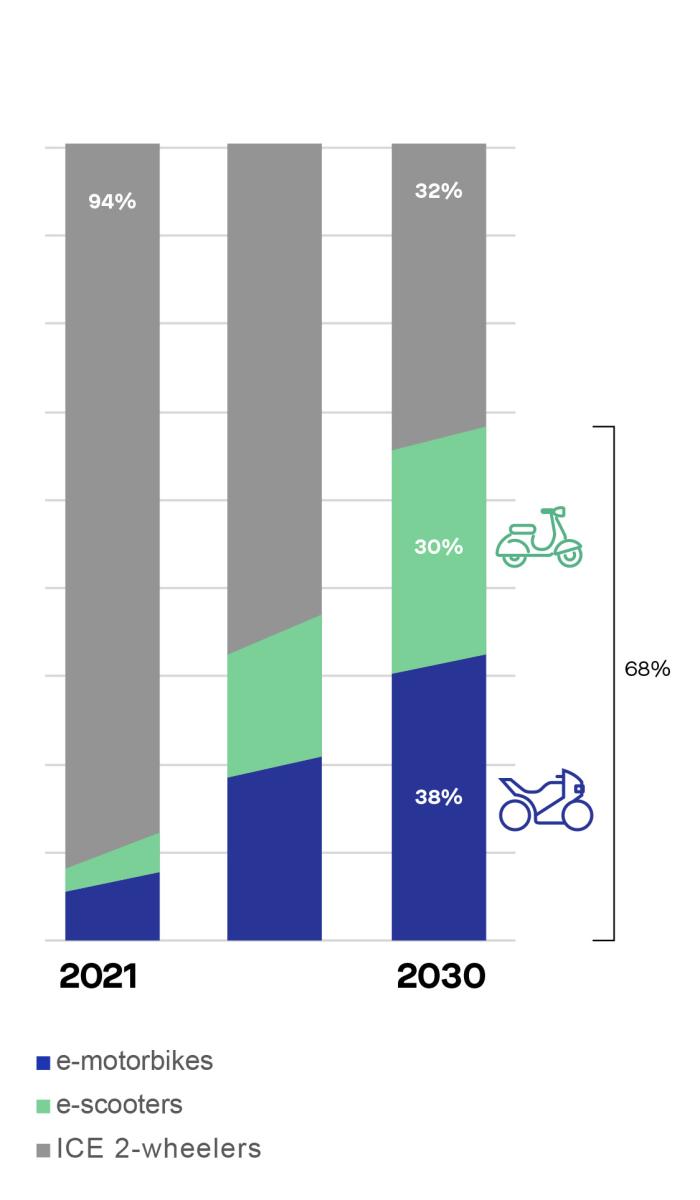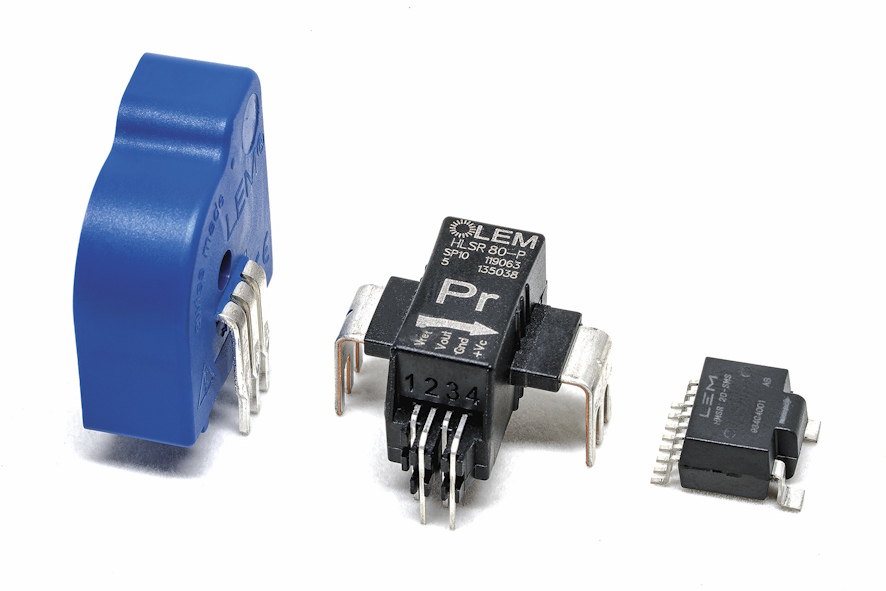How Current Sensor IC will Drive the e-mobility sector Electrification
The Growing Impact of Electrification in the Transport Sector
Electrification has become a major factor in the transport sector because it is one of the main contributors to greenhouse gas emissions. As countries strive towards the target of global CO2 neutrality by 2035, cars, buses and taxis have been at the forefront of change. Electric vehicles (EVs) have become commonplace, taxis glide silently up our high streets and ‘100% electric’ vans and buses deliver parcels and people to their destinations.
However, with so much focus on EVs, it would be easy to overlook the light e-mobility sector, in particular the growing demand for the electrification of two- and three-wheel vehicles. While EVs have certainly garnered most of the attention and prominence in the transport sector, a much larger trend has been developing around the world.
Rapid Growth in the Electrification of Light Mobility Vehicles

The light mobility sector has experienced a significant acceleration in terms of electrification, in particular in South East Asian countries such as Malaysia and Indonesia, as well as India, China (and soon Africa) where two-wheel transportation is by far the most common means of transport. It has been estimated that there are around 70 million two-wheelers on the road and the numbers are growing at a rapid pace. It is widely expected that electrification of two-wheel vehicles will become more common in northern economies in the coming decade, with many companies in the USA and Europe already looking into launching products into this market.
In terms of growth, this sector is expanding faster than the four-wheeler market, not least because certification and design issues are much less complex. Similarly, battery management systems (BMSs) are easier to design for the sector because two-wheeler batteries are smaller with less power and voltage. All of this means that start-ups are able to address electric mobility issues much easier in the two-wheeler market than if they were having to design EV systems from scratch.
In 2021 around 6% of light mobility vehicles were electrified, the rest relying on the internal combustion engine (ICE). By 2030, it is estimated that e-scooters and motorbikes will between them represent 68% of the two-wheeler market. In more detail, sales of e-scooters are expected to reach 30 million within the next six years, e-motorbikes 23 million and e-bikes 40 million. At present, the electric two-wheeler market is based around 48V e-scooters but the growth is expected to come mainly from 100V-200V e-motorbikes followed by electric bikes with 36V systems. In India, powerful motorbikes represent the largest two-wheeler market and its growth is already inspiring a fresh wave of electric designs where lightweight, compact and durable components are essential requirements.
The Role of Integrated Current Sensors (ICSs) in Enhancing E-Mobility and Electric Two-Wheelers
LEM believes that Integrated current sensors (ICSs), with the current sensing function integrated into a single semiconductor unit, will be at the epicentre of the e-mobility market. This is because they combine precision, reliability and high-power density with a versatile and cost-effective means of addressing the voltage and current diversity that characterises this sector. In such a competitive and price sensitive environment, Current Sensor IC are able to offer an immediate solution for keeping costs down while also making maximum use of PCB space.
In addition, they play a vital role in maximising safety, particularly in controlling BMSs which can enable batteries to have working lives of at least 10 years under normal operating conditions.

Miniaturizing the current sensing function
LEM has had its eye on this key strategic market for many years and is developing a portfolio that meets the requirements of the light mobility sector – especially electric two-wheelers with three-phase AC motors – with products that are just as advanced as those that are used in EVs. LEM’s range of ICSs covers every part of the e-mobility sub-system which would typically include up to eight sensors per vehicle.
There are three main areas where Current Sensor ICs represent the best fit for electric two-wheelers. The first is power conversion, where the charger turns AC power from the grid into DC for the vehicle’s Lithium Ion (Li-Ion) battery.
In turn, there are typically three measurement points for current sensing in the charger that focus not just on power conversion but also on efficiency and control:
- one integrated current sensor carries out AC input measurement where the charger needs to check the current going into the system.
- a second ICS monitors the power transistors and switches that convert the signal from AC to DC. This current sensor synchronises the transistors to make sure the conversion is carried out in an efficient way.
- finally, a DC output current sensor measures the current that goes out of the system and compares it with the expected output current. Any difference will indicate a problem at the conversion stage which the microcontroller will need to adjust to ensure the desired output current is achieved.
Typical LEM ICSs used in this area would include GO sensors because the input sensor needs to be isolated due to the grid voltage. With the AC grid at around 200V-220V, at the input stage a GO SME ICS would be ideal for low current or a GO SMS for higher current. GO SME sensors are also suitable at the output stage because less isolation is required when working with 48V batteries.
Key Applications of Integrated Current Sensors in Electric Two-Wheelers: BMS and Motor Control
The second key area for Integrated Current Sensors in electric two-wheelers is the BMS, with the aim of avoiding battery damage as well as potentially catastrophic failure events such as a fire or explosion. Operating as a protection and safety device, a single sensor in the BMS checks if there is a rush current or surge current in or out of the battery. If there is, the Current Sensor IC will instruct the microcontroller to open the relay to prevent any more energy from going through the battery.
Often, the ICS will work alongside a shunt that uses different technology to carry out the same measurements, with the microcontroller comparing the signals. This double redundancy means that if there is a failure of one sensor for any reason the other will continue to take measurements.

Typical e-mobility application and current measurement points.
The third area where Current Sensor ICs are ideal for electric two-wheelers is motor control, where the DC current from the battery is turned into three-phase AC current to operate the electric motor that runs the vehicle. Typically, four sensors would be operating here – one at the input stage and three at the output, all capable of being soldered automatically and directly on to the face of the PCB and take up minimum space.
Again, the microcontroller is involved in checking that input and output levels are as expected. Safety is enhanced by all sensors at the input and output working in harmony to compare rates and ensure the operation is running as it should. With the microcontroller managing transistor gate drivers using the signal sent by the current sensor, this is a highly efficient control loop which provides accurate control over the motor. The result for the end user is smooth acceleration and maximum operational efficiency of the vehicle.
Typical LEM isolation current sensors IC used in this area would be the HMSR SMS family, particularly because of a large primary conductor with very low electrical resistance and dedicated pads that make it capable of handling high currents if required. Featuring a micro magnetic core, HMSR sensors are immune to external fields, making them ideal for power electronic applications that have high levels of disturbance.
The Advantages of Integrated Current Sensors in Light Mobility Vehicles
In short, integrated current sensors in electric two- and three-wheel vehicles are capable of offering superior performance in a smaller low-cost package that delivers impressive levels of power density in light mobility applications. The sensors combine high levels of isolation and accuracy with the ability to handle higher currents but in a more integrated package that can deal with issues directly on the PCB.
The global electrification of two- and three-wheel vehicles is set to take off and by delivering on precision, reliability, integration and power density, LEM’s expanding portfolio of integrated current sensors will play a vital role in helping to drive growth in this sector.